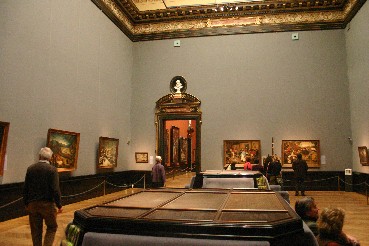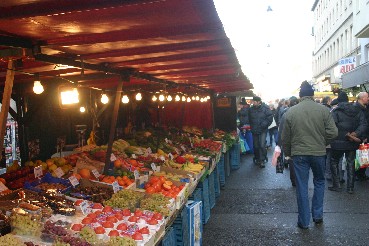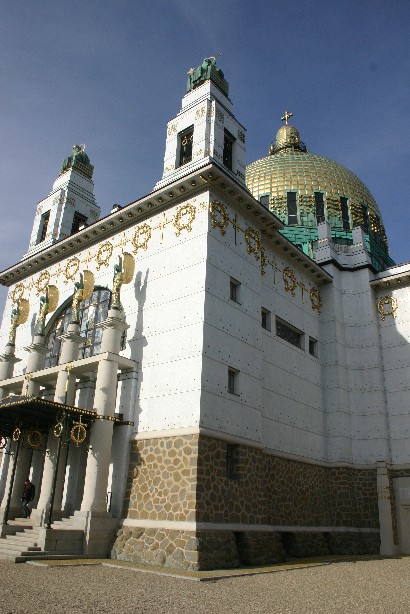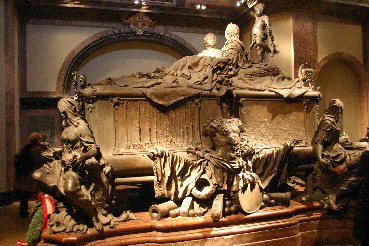Friday 30 November 2007
We take tram and U-bahn to Stephansplatz
and walk down Graben and Kohlmarkt to Café
Demel. They are still closed, much to our regret. We kill time by retracing our
steps to  Meinl am Graben.
This is delicatessen department store, reminding of Harrod's food department in
London. They have the most exquisite food stuffs from all over the world. The
choice of high value chocolate, fish, meats, vegetables, fruit, cheeses, wine,
bread and much more is overwhelming. A gourmet's paradise. At 10 we head
back to Demel, where they have some
trouble opening the door. We take a seat in the upstairs salon and indulge in
delicious cake and Viennese coffee. The history of this prestigious coffee house
and bakery (Imperial & Royal Court Confectioners) goes back to 1786. We
can look inside the bakery itself through a glass wall. Downstairs is the shop
with a wide variety of cakes, chocolates and other goodies are on display. After
this lovely start of the day we walk through the Hofburg towards the Kunsthistorisches
Museum. The collection is originates in the imperial house collection of
the Habsburgs and is housed in a purpose built museum on the Ringstrasse across
from the palace. It is separated by a small park from the almost identical
building of the Naturhistorisches Museum. The museum building is a
work of art in its own right. We walk through it Meinl am Graben.
This is delicatessen department store, reminding of Harrod's food department in
London. They have the most exquisite food stuffs from all over the world. The
choice of high value chocolate, fish, meats, vegetables, fruit, cheeses, wine,
bread and much more is overwhelming. A gourmet's paradise. At 10 we head
back to Demel, where they have some
trouble opening the door. We take a seat in the upstairs salon and indulge in
delicious cake and Viennese coffee. The history of this prestigious coffee house
and bakery (Imperial & Royal Court Confectioners) goes back to 1786. We
can look inside the bakery itself through a glass wall. Downstairs is the shop
with a wide variety of cakes, chocolates and other goodies are on display. After
this lovely start of the day we walk through the Hofburg towards the Kunsthistorisches
Museum. The collection is originates in the imperial house collection of
the Habsburgs and is housed in a purpose built museum on the Ringstrasse across
from the palace. It is separated by a small park from the almost identical
building of the Naturhistorisches Museum. The museum building is a
work of art in its own right. We walk through it with the help of an audio guide (€3). Right now there is an exhibition of the
"late Titian”. Interesting, but the permanent collection is impressive
enough. It comprises the largest collection of Bruegels in the
world. An entire room is filled with works like “Peasant Wedding”, “Hunters
in the snow” and the “Tower of Babel”. It is all very impressive. We make
a selection of the rooms of the picture gallery we want to have a look at. They
are located on the second floor around two inner courts. Other highlights are
paintings by Dürer, among which an altar piece “Adoration the
Trinity”. There are also rooms with works by
Rubens,
among which a painting - The fur - with his second wife, Helene
Fourment who he married when she was only 16 years old. The museum has three
self portraits by Rembrandt from his later period when he was
financially down on his luck. The painter looks us straight in the face, full of
life. There is only one Vermeer: "The Artist's Studio".
Also the Italians and the Spaniards are well represented by Carravaggio,
Titian and Velazquez. The ground floor is taken up by ancient art
from Egypt, the Near East, Greece and Rome. We leave that for now. After almost
3 hours we are "full".
with the help of an audio guide (€3). Right now there is an exhibition of the
"late Titian”. Interesting, but the permanent collection is impressive
enough. It comprises the largest collection of Bruegels in the
world. An entire room is filled with works like “Peasant Wedding”, “Hunters
in the snow” and the “Tower of Babel”. It is all very impressive. We make
a selection of the rooms of the picture gallery we want to have a look at. They
are located on the second floor around two inner courts. Other highlights are
paintings by Dürer, among which an altar piece “Adoration the
Trinity”. There are also rooms with works by
Rubens,
among which a painting - The fur - with his second wife, Helene
Fourment who he married when she was only 16 years old. The museum has three
self portraits by Rembrandt from his later period when he was
financially down on his luck. The painter looks us straight in the face, full of
life. There is only one Vermeer: "The Artist's Studio".
Also the Italians and the Spaniards are well represented by Carravaggio,
Titian and Velazquez. The ground floor is taken up by ancient art
from Egypt, the Near East, Greece and Rome. We leave that for now. After almost
3 hours we are "full".
We walk to the Museumsquartier
a bit further down. In the courtyard of
the former imperial stables a number of museums and exhibition halls have been
built, together forming the MQ since 2001. There are also restaurants and bars
and we head for Die Halle, the restaurant above the Kunsthalle. It is a
tediously long wait for our food (over 40 minutes) it tastes good. Getting the
bill is also a bit of trial.
After lunch we take the
underground and tram to the Zentralfriedhof.
This is the big central cemetery of Vienna, south of the city. It is a gigantic
cemetery, as big as the inner city itself (2,4 ha/ 6 acres) and has around 2.5 million
"inhabitants". There is even a bus service on the cemetery itself and
many visitors use their car to get to the grave of their loved ones. The
cemetery was founded in 1874 as the first all denomination cemetery and
controversial for that very reason. Apart from Roman Catholic sections, there
are sections for secular, protestant, orthodox, evangelical and Jewish
burials. The Ehrengräber (honour graves) of Viennese celebrities are
fortunately not too far from entrance number 2. Tram lines 6 and 71 stop at
entrances 1 through 3. Close to each other we find the two composers Beethoven
and Brahms (moved here in 1899). During the reburial, guards had
to restrain composer Anton Bruckner who wanted to touch the bodies. A bit
further up we see the graves of the musical members of the Strauss
family
inner city itself (2,4 ha/ 6 acres) and has around 2.5 million
"inhabitants". There is even a bus service on the cemetery itself and
many visitors use their car to get to the grave of their loved ones. The
cemetery was founded in 1874 as the first all denomination cemetery and
controversial for that very reason. Apart from Roman Catholic sections, there
are sections for secular, protestant, orthodox, evangelical and Jewish
burials. The Ehrengräber (honour graves) of Viennese celebrities are
fortunately not too far from entrance number 2. Tram lines 6 and 71 stop at
entrances 1 through 3. Close to each other we find the two composers Beethoven
and Brahms (moved here in 1899). During the reburial, guards had
to restrain composer Anton Bruckner who wanted to touch the bodies. A bit
further up we see the graves of the musical members of the Strauss
family and that of Franz Schubert (1797–1828), who died of syphilis. He
contracted the disease during his only sexual encounter with a woman. Otherwise
the composer was partial to men. He lived for two years with his, openly gay,
librettist, Johann Baptist Mayerhofer in digs, where they also shared the bed.
Their orientation is noticeable in various texts, that Mayerhofer wrote for Schubert's
compositions, including an unfinished opera called „Adrast“.
and that of Franz Schubert (1797–1828), who died of syphilis. He
contracted the disease during his only sexual encounter with a woman. Otherwise
the composer was partial to men. He lived for two years with his, openly gay,
librettist, Johann Baptist Mayerhofer in digs, where they also shared the bed.
Their orientation is noticeable in various texts, that Mayerhofer wrote for Schubert's
compositions, including an unfinished opera called „Adrast“.
We go on and find more graves
of artists like the Viennese sculptor Fritz Wotruba, who designed
his own headstone, but also the one for composer Schönberg, who died in 1951 in Los Angeles. Bruno
Kreisky, the long time social-democrat Federal Chancellor (1970-83) lies here too with his
wife. In a newer section of the cemetery, past the Karl Lueger church we find the grave of Hans Hölzel (1959-98), better known as Falco. In
1986 he became world famous with hits like "Rock me Amadeus" and "Jeanny".
The grave is surely in his style..
we find the grave of Hans Hölzel (1959-98), better known as Falco. In
1986 he became world famous with hits like "Rock me Amadeus" and "Jeanny".
The grave is surely in his style..
With tram, underground
and tram we ride to Grinzing, on the other side of town in the
hills in direction of the Wienerwald. The wine village has been incorporated
into Vienna a long time ago. Here we find the so called Heurigen, wine bars, where
the new wine is served (Heuer means "this year" in Austrian German). We
go to Reinprecht. It bit
touristy, but great fun nonetheless. You lay a foundation by ordering something
from the deli buffet. The Heurige Wine comes in a mug of 0.3 litre and is easy
to drink. After the wine and a bite we take the tram and underground back to the
hotel. We change clothes and go out and take the underground to Herrengasse near
the Hofburg. We walk to restaurant RieGi
(1 star by Michelin) where we have a wonderful dinner. I take goose liver and
dove breast. Erik enjoys his Kohl Rabi cake and Veal steak. Our sweet is a
delicious crêpe with passion fruit. We wash it all down with a good Austrian
red (Vöslauer). After dinner we walk through beautifully lit inner city to the Felixx
bar for a drink. It is very busy.
Saturday 1 December 2007
We check out of our hotel and
take our luggage with the tram to Railway Station Mitte, two stops up the road.
Here is the City Airport Train
terminal, where we can check in for tonight's flight with Austrian. We
can check in our luggage. That is a relief. We have our boarding passes and
relieved from our luggage until we arrive in Amsterdam. Tonight we take the City Airport Train
from here to Schwechat, Vienna's airport.
Today we are meeting Wolfgang
again. We wait in front of U-bahn station Josefstädterstraße, where he meets us at around 10am.
With Wolfgang walk over the Brunnengasse
street market in the Josefstadt district. It is a working class district,
with lots of immigrants, but gentrification is on its way. The district is
fairly mixed. Wolfgang does some shopping on the market. With Wolfgang we have
coffee in an Italian deli on Yppenplatz,
front of U-bahn station Josefstädterstraße, where he meets us at around 10am.
With Wolfgang walk over the Brunnengasse
street market in the Josefstadt district. It is a working class district,
with lots of immigrants, but gentrification is on its way. The district is
fairly mixed. Wolfgang does some shopping on the market. With Wolfgang we have
coffee in an Italian deli on Yppenplatz, after which we take a taxi to the Baumgartner Höhe. Here is, next to the
psychiatric hospital Steinhof a beautiful Art Nouveau / Jugendstil
church by architect Otto
Wagner from 1907. Unfortunately the church is not open right now, in the
morning sun light the church is magnificent sight. It is a cross basilica, with
a gold plated dome. Typical Jugendstil are the stain glass windows by Kolo
Moser. The church echoes a bit the forms of the Karlskirche. We stroll around
the recreational area around the church, that once was part of the psychiatric
facility. After a while we get to the Schloß
Wilhelminenberg a classical hotel with a grand view over the city.
There is a small ice rink next to it at the moment. We continue a bit and arrive
at Villa
Aurora, a 19th century villa, now a restaurant serving
classic Austrian fare. We take the Wiener schnitzel. They are huge, but thin and
of great quality. .
after which we take a taxi to the Baumgartner Höhe. Here is, next to the
psychiatric hospital Steinhof a beautiful Art Nouveau / Jugendstil
church by architect Otto
Wagner from 1907. Unfortunately the church is not open right now, in the
morning sun light the church is magnificent sight. It is a cross basilica, with
a gold plated dome. Typical Jugendstil are the stain glass windows by Kolo
Moser. The church echoes a bit the forms of the Karlskirche. We stroll around
the recreational area around the church, that once was part of the psychiatric
facility. After a while we get to the Schloß
Wilhelminenberg a classical hotel with a grand view over the city.
There is a small ice rink next to it at the moment. We continue a bit and arrive
at Villa
Aurora, a 19th century villa, now a restaurant serving
classic Austrian fare. We take the Wiener schnitzel. They are huge, but thin and
of great quality. .
We take the bus back to down
town and say goodbye to Wolfgang. We go on by tram to the Ringstraße where we
get off. We walk along the parliament and the town hall and get
to the Hofburg again. After a coffee at Starbucks we walk to the Neuer Markt. In
middle of the - because of many parked cars - chaotic square is the Providentia-fountain
by sculptor
Georg Raphael Donner (1693-1741). It is also known as the Donner fountain.  The
central figure is the Providence surrounded by personifications of tributaries
to the Danube river in Lower Austria. Empress Maria Theresia thought the statues
to sensual and had them removed in 1770 to have them melted into canons. The
returned undamaged in 1801. In 1873 they were replaced by bronze replicas. The
river Traun is represented by a well built young man, holding his trident over
the water to catch a fish. His buttocks must have been to prominent for the
taste of the day, hence the discreetly applied fig leave! We are here to visit
the Kaisergruft. A simple church
stands over an enormous cellar where 143 Habsburgs have their ornate tombs. Most
of the sarcophaguses are made of pewter. Especially the the tomb of Maria Theresia
and her husband Franz Stephan is impressive. It is more than three metres high The
central figure is the Providence surrounded by personifications of tributaries
to the Danube river in Lower Austria. Empress Maria Theresia thought the statues
to sensual and had them removed in 1770 to have them melted into canons. The
returned undamaged in 1801. In 1873 they were replaced by bronze replicas. The
river Traun is represented by a well built young man, holding his trident over
the water to catch a fish. His buttocks must have been to prominent for the
taste of the day, hence the discreetly applied fig leave! We are here to visit
the Kaisergruft. A simple church
stands over an enormous cellar where 143 Habsburgs have their ornate tombs. Most
of the sarcophaguses are made of pewter. Especially the the tomb of Maria Theresia
and her husband Franz Stephan is impressive. It is more than three metres high and
wide and six metres long. The pair sits on top and looks at each other with love
in their eyes. At their feet lies their son Josef II, who did not like this kind
of pomp at all. Further down is the tomb of emperor Maximilian of Mexico.
His elder brother,
Franz Josef occupies, together with his son Rudolf (who committed suicide in 1889)
and his much admired wife Elizabeth (Sisi) a separate room. Franz Josef's grave is
adorned with fresh flowers, while Sisi's has ribbons in he Hungarian colours. and
wide and six metres long. The pair sits on top and looks at each other with love
in their eyes. At their feet lies their son Josef II, who did not like this kind
of pomp at all. Further down is the tomb of emperor Maximilian of Mexico.
His elder brother,
Franz Josef occupies, together with his son Rudolf (who committed suicide in 1889)
and his much admired wife Elizabeth (Sisi) a separate room. Franz Josef's grave is
adorned with fresh flowers, while Sisi's has ribbons in he Hungarian colours.
We walk to the Stadtpark
on the East side of inner Vienna. Here are some statues of composers, among
which a gold coloured one of Johan Strauss jr. Viennese and tourists alike
stroll through this relatively quiet piece of green land, in middle of town. We
walk to Café Engländer a
typical Viennese café, where have a drink before we head for the airport by
underground and City Airport Train. We are
still quite full after the Schnitzel earlier today, so we only take a small
snack at the airport. Our flight is slightly delayed and we arrive around 9.30pm
at Amsterdam Airport. With a train and taxi we are back home around 11pm.
|

